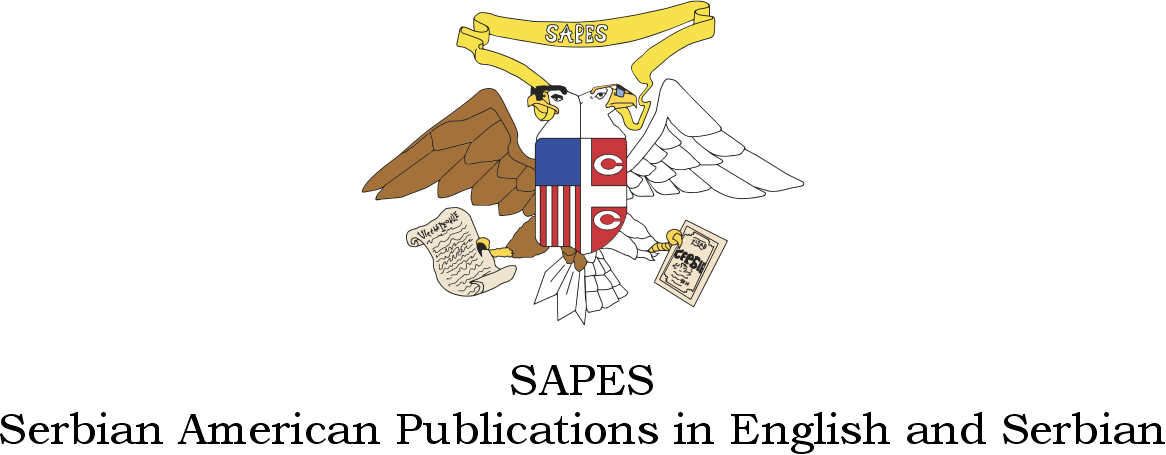SAPES (1900-1960) Project:
The research project Written Cultural Heritage of Serbian Diaspora in the USA (1): Serbian- American Papers (Publications) in English and Serbian, SAPES (1900-1960) Grant. No. 6462817 funded by the Science Fund of the Republic of Serbia (www.fondzanauku.gov.rs) is part of the research-project cycle Collaboration of Serbian Science with the Diaspora that was initially launched in 2020. The Project was designed as a short-time, one-year research project that was to set path and provide foundations and initial materials for future Diaspora studies in Serbia. Due to the COVID-19 pandemic, the Project was delayed and officialy started in spring 2021. Given the amount of the collected data and research materials, the duration of the project was extended until August 2023. Since the entire project cycle’s objective was to stimulate and support the collaboration of Serbian scholars and researchers in the homelamd with their peer compatriots aborad, the SAPES (1900-1960) Project was realized as a collaborative project between the University of Belgrade (Faculty of Philology) and Wayne State University, Detorit, MI, USA.
The project team-members are Prof. Dr. Jelena Vujić (Primary Investigator) and Prof. Dr. Aleksandar Milanović (team-member) from the Faculty of Philology and Prof. Dr. Ljiljana Progovac (scholar/expert from the Diaspora), a renowned linguist from Wayne State University.
Having strong professional and family ties in the USA and having lived in Chicago for a period of time, Prof. Vujić had had insight into the rich Serbian written cultural heritage that was of limited availability to the researchers in Serbia due to various socio-historical circumstances in the past. This vast body of written and/or printed materials found in the libraries and archives of Serbian organizations and institutions as well as in personal archives across the USA had not been widely digitized at the time and was in danger of decay and/or loss. Consequently, when the Science Fund opened a call for research projects which would entail collaboration with the Serbian Diaspora, it was an ideal opportunity to provide funding which would help preserve the valuable written materials through their digitization. This would enable future research into the linguo-stylistic and socio-pragmatic aspects of the Serbian spoken in by the members of the Serbian Diaspora in the USA, which has emerged as a fully profiled contact variety of Serbian. This language is an important witness of the Serbian socio-cultural identity in the USA.
SAPES (1900-1960) Project’s main objectives:
- Compiling a representative language corpus of writings including periodicals, newspapers, bulletins, almanacs, magazines, language learning materials, political studies, novels, short stories, poems, manuals and items of personal correspondence published in Serbian and English in the USA from the late 1800s until the late 1960s.
- Formation of a digital database which will preserve the valuable printed data from being lost and make it available to Serbian scholars and researchers.
- Setting the foundations for inclusion of such important writings in both Serbian and English (authored by Serbian immigrants in the USA) into the corpus of Serbian cultural heritage. While many other Slavic nations have already created databases of diaspora cultural heritage (e.g. Polish, Ukrainian, Russian, Slovenian, etc.), the Serbian diaspora culture has yet to be properly valued and find its place as a unique segment of the Serbian cultural heritage. We firmly believe that the Serbian diaspora is integral part of diverse Serbian national identity and hope that the outcomes of SAPES (1900-1960) Project will inspire other researchers to show interest in this vast material treasure.
In addition, the written data in question present the only evidence of the Serbian language spoken and used by the Serbian diaspora across the American continent in the early 1900s. Through our diachronic sociolinguistic description, based on what is known about both the past and the present-day Serbian speaking community in the USA, we would like to reconstruct (and revive) the (socio)linguistic circumstances of the earliest formation stages of the variety of the Serbian language which has persisted to be used for more than a century having developed into a focused and distinctive American Diaspora Serbian dialect.
- Corpus:
The coprus presented on this site was collected from the libraries and archives of various Serbian (and American) institutions, organizations, churches and cemeteries as well as the private archives across Illinois (Chicagoland), Wisconsin (Milwaukee and Kenosha), Michigan (Detroit), Ohio (Cleveland) and Indiana (Gary, East Chicago and Merryville). The corpus was collected during the months of July and August 2021. The libraries and archives of the following organizations and institutions were researched: Saborni hram Sv. Lazara− Ravanica (Serbian Orthodox Cathedral St. Lazarus− Ravanica), Detroit, MI, Srpski kulturni muzej in “Sveti Sava” Church (Serbian Cultural Museum), Merrillville, IN, Sveti Đorđe Church (St. George Church) in East Chicago, IN, Srpska narodna odbrana (Serbian National Defense) in Chicago, IL, Manastir Nova Gračanica (Nova Gračanica Monastery), Third Lake, IL, Manastir Svetog Save (St. Sava Monastery), Libertyville, IL and Center for Research Libraries, Chicago, IL.
The corpus incorporates the following:
- 6000+ pages scanned and/or photographed including multiple issues of papers and magazines, monographs, other publications (e.g. dictionaries, language learning and literacy textbooks etc.) and personal letters, cards, poems authored by Serbian immigrants.
- 500+ tombstones photographed in two Serbian cemeteries. They are a valuable of the corpus are tombstone writings which are important indicators of the Serbian American identity.
Acknowledgments
The project-team members are thankful to the Science Fund of the Republic of Serbia for recognizing the value and potential of SAPES (1900-1960) by awarding it the funding. This is unique research that would not have been possible without the Science Fund’s financial support. However, other organizations and individuals are also to be thanked for their support and contribution. Our endless thanks goes to the Serbian Diaspora members in: Saborni hram Sv. Lazara− Ravanica (Serbian Orthodox Cathedral St. Lazarus− Ravanica) in Detroit who readily opened their door to us. We extend our gratitude to Srpska narodna odbrana (Serbian National Defense) in Chicago and its President at the time Mr. Dragan Vujošević as well as to its members. We would like to thank the members of Manastir Nova Gračanica (Nova Gračanica Monastery), Father Serafim Baltić in particular, for their support. In addition, for all their selfless assistance and support, we are indebted to the faculty and staff at Wayne State University, who went that extra mile to make the neccessary resources available to us in the challenging times of the lockdowns.We appreciate all the help from the staff at the Center for Research Libraries in Chicago. But for all their support, we would not have been able to realize the projected goals of the project.
Finally, we thank to Mr. Filip Lukić for devising and managing the website and to Mr. Simeon Nešić, a young and talented artist for designing the project’s logo.

